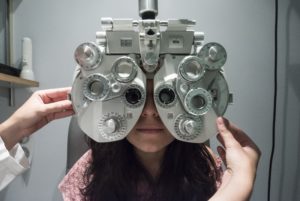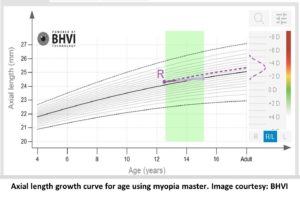May 2, 2022
By Zeeshan Akhtar, PhD Candidate, Brien Holden Vision Institute
 Myopia is characterized by excessive elongation of axial length (AL). Although refractive error assessment is commonly used to diagnose and monitor myopia, modern technology for axial length (AL) measurements using partial coherence interferometry and swept-source techniques is more accurate. It is also rapid, non-invasive, and more advantageous to monitor AL changes. Additionally, recent reports suggest axial length/corneal curvature (AL/CR ratio) correlates more significantly with refractive status of the eye than the AL alone.
Myopia is characterized by excessive elongation of axial length (AL). Although refractive error assessment is commonly used to diagnose and monitor myopia, modern technology for axial length (AL) measurements using partial coherence interferometry and swept-source techniques is more accurate. It is also rapid, non-invasive, and more advantageous to monitor AL changes. Additionally, recent reports suggest axial length/corneal curvature (AL/CR ratio) correlates more significantly with refractive status of the eye than the AL alone.
In this article, the authors developed and validated age and sex-specific percentile curves of AL and AL/CR for 14,127 Chinese children between 4-18 years using the lambda-mu-sigma (LMS) method and used the sample to determine the probability of myopia and estimate refractive error. Percentile charts provide an easy visual means to determine where an individual is placed relative to the population for myopia and future progression.
Age and gender-specific 3rd, 5th, 10th, 25th, 50th, 75th, 90th, and 95th percentiles for AL and AL/CR are presented. As expected, there was an increase in AL, AL/CR, and myopic shift in refractive error with increasing age. Females were more myopic with shorter AL, steeper CR, and lower AL/CR values. A year-wise increase in AL and AL/CR values across all percentiles was noted except below the 10th percentile from 15 years of age and older. Also, the year-wise change in AL and AL/CR from 4-18 years was more in higher percentiles compared to lower. For instance, at the 25th percentile the overall changes in AL and AL/CR for male/female was 2.51/2.78mm and 0.29/0.32, whereas at the 95th percentile, it was 4.41/4.59mm and 0.58/0.60 respectively. The probability of myopia increased significantly from age 10, with AL/CR >3.0 and AL >23.5 for both genders. At ≥ 50th percentile, for both AL and AL/CR, Chinese children had a >95% probability of myopia by age 15. Compared to other ethnicities, longer AL with a 2.5 times greater rate of change in Chinese children was found in this study.
The model used for myopia probability was highly comparable with other screening methods, with 84.5% sensitivity and 86% specificity. The AL and AL/CR percentiles presented in this study can monitor changes in AL and AL/CR over time and estimate the risk of myopia and future progression. Furthermore, probability estimates using AL and AL/CR may also aid in screening and estimation of myopia.
Abstract
Normative Data and Percentile Curves for Axial Length and Axial Length/Corneal Curvature in Chinese Children and Adolescents Aged 4-18 Years
Xiangui He, Padmaja Sankaridurg, Thomas Naduvilath, Jingjing Wang, Shuyu Xiong, Rebecca Weng, Linlin Du, jun Chen, Haidong Zou, Xun Xu
Purpose: To develop age-specific and gender-specific reference percentile charts for axial length (AL) and AL/corneal radius of curvature (AL/CR) and to use percentiles to determine the probability of myopia and estimate refractive error (RE).
Methods: Analysis of AL, cycloplegic RE and CR of 14,127 Chinese participants aged 4–18 years from 3 studies. AL and AL/CR percentiles estimated using Lambda-Mu-Sigma method and compared for agreement using intraclass correlation (ICC). Logistic regression was used to model risk of myopia based on age, gender, AL and AL/CR percentiles. Accuracy of AL progression and RE estimated using percentiles was validated using an independent sample of 5,742 eyes of children aged 7–10 years.
Results: Age-specific and gender-specific AL and AL/CR (3rd, 5th, 10th, 25th, 50th, 75th, 90th and 95th) percentiles are presented. Concordance between AL and AL/CR percentiles improved with age (0.13 at 4 years to >0.75 from 13 years) and a year-to-year change was observed for all except <10th percentile from 15 years. Increasing age, AL and AL/CR was associated with a more myopic RE (r2=0.45,0.70 and 0.83, respectively). The sensitivity and specificity of the model to estimate probability of myopia was 86.0% and 84.5%, respectively. Estimation of 1-year change in AL using percentiles correlated highly with actual AL (ICC=0.98). Concordance of estimated to actual RE was high (ICC=0.80) and within ±0.50D and ±1.0D of actual RE for 47.4% and 78.9% of eyes, respectively.
Conclusion: Age-specific and gender-specific AL and AL/CR percentiles provide reference data, aid in identifying and monitoring individuals at risk of myopia and have utility in screening for myopia. AL/CR percentiles were more accurate in estimating probability of myopia in younger children.
He, X., Sankaridurg, P., Naduvilath, T., Wang, J., Xiong, S., Weng, R., … & Xu, X. (2021). Normative data and percentile curves for axial length and axial length/corneal curvature in Chinese children and adolescents aged 4–18 years. British Journal of Ophthalmology.
DOI: http://dx.doi.org/10.1136/bjophthalmol-2021-319431
 |
Zeeshan Akhtar is a PhD candidate at Brien Holden Vision Institute supervised by Prof. Padmaja Sankaridurg & Arthur Back. |














